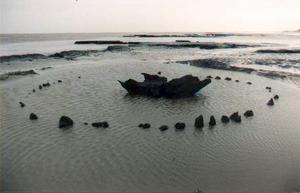Nearly 10 years after its controversial excavation, the mystery remains. While the upturned oak tree and its ring of timbers have taught us a few things we didn't know about our ancestors, we still don't know why they built it.

|
| ©Andy Burnham |
Late in 1998, a long-forgotten landscape began re-emerging from beneath the sands of Holme Beach, near Hunstanton.
Beds of freshwater peat - all that remained of the salt marsh and forest which bordered the sea more than 4,000 years ago - were being uncovered by the tides.
All that time, the peat had kept a secret. It had almost perfectly preserved a timber circle and the remains of what appeared to be other structures nearby, fossilising a snapshot of a lost society.
Sightseers flocked to see the circle after its discovery became public. Conservationists feared they would disturb the remote site's wading birds and trample what remained of the peat beds.
Druids said the circle was sacred and should be left intact to preserve its mystical energies.
Archaeologists lopped a chunk off the stump with a chainsaw, so they could take it away and see how old it was. Then they said they wanted to dig it up.
Many believed the relic should be left where it was. Older villagers said similar structures had appeared elsewhere on the beach as recently as the 1970s, only to be covered again by the shifting stands as winter storms lashed the coast.
There were angry meetings and high court writs. Protestors came from across the country and an uneasy stand-off ensued as excavation work began in the late spring of 1999. By early summer, parts of the foreshore were cordoned off while police stood guard.
A woman burst through and hurled herself, screaming, at the central stump, the day a digger tore it free from the peat. She was grappled to the sands as the tree was placed on a dumper truck and driven away across the beach.
Experts were convinced they would find a key to the mystery beneath the upturned oak. Human remains, a hoard of treasure, or some other clue as to why the timber circle was built would surely lay beneath its bulk. But the great hole it left behind until the next tide was empty.
Archaeologists can now argue that what they discovered about the timbers vindicated the decision to remove them. Area museums officer Dr Robin Hanley said the circle was unique in Europe and of international importance. Some regard it as one of the most significant archaeological discoveries of the 20th century.
Such circles may once have been common, of course. But Seahenge is so far the only structure of its kind to have survived almost intact.
Scientific dating showed its timbers came from trees which were felled in the spring of 2049BC. Marks from the vines used to drag them out across the marsh could still be seen.
Sophisticated microscopy revealed one timber had marks from up to 50 bronze axes, each with its own signature. The nicks and grooves - which can be seen in the timbers - were the biggest revelation of all.
They showed that early Bronze Age society was more advanced than had previously been believed. The use of tools was widespread and people were capable of working together in large teams much earlier than had been thought.
While forensic work has told us much about the physical make-up of the circle and the land around it nearly 4,060 years ago, its purpose remains a mystery to this day.
"Archaeologists are still debating what it was used for," said Dr Hanley. "There are a number of theories, but the most popular was that a body was placed on the stump.
"It must have been someone important - a chief or priest perhaps - if large numbers of people were involved in building something on this scale.
"When people approached it would have been like a ring of posts, eight or 10ft high, it would have looked like an enormous tree."
Every so often, the windswept beach at Holme gives up more secrets.
Fragments of woven wickerwork have emerged. Lines of posts criss cross the peat, some leading to the remains of what appeared to be other circular structures, which have since been lost to the sea.
Were they simple walkways, built so our ancestors could safely traverse the swamps on their way to and from the coast? Or were they part of some sacred site beyond our comprehension, part of a pre-Christian spiritual landscape we have long since forgotten how to navigate?
While we may never know for certain, we can soon marvel at its centrepiece. While officialdom once shrugged over where funds to properly preserve and accommodate the timbers would come from, the penny has now dropped over their value as a window on our past.
The timbers have been preserved by the Mary Rose Trust, in Portsmouth, before being transported to Gressenhall to be made ready for display.
A £1m development is under way at Lynn Museum to house them, funded by the Heritage Lottery Fund and Norfolk County Council.
From next Easter, visitors will also be able to explore a full-sized replica of Seahenge as it would have appeared in the Bronze Age - half of it made from the original timbers, in special cases, the rest faithful reproductions. The enigmatic central stump, which is still undergoing preservation work, will eventually be joining it.
"This is a really exciting time for us," said Dr Hanley, as work continued on the timbers yesterday. "It's fantastic that this find of international significance is returning to Norfolk."



Reader Comments
to our Newsletter